Now Viewing:
Hide Featured Image

Jacques and Therese Makowsky and the Development of the Cornish Game Hen
In 1950, the Makowskys crossed a white Cornish cock with a White Plymouth Rock hen to produce a small hybrid that they patented as the Rock Cornish Game Hen.
Read
Fuller Brush Tower Collapses – Today in History: March 31
On March 31, 1923, a 56,000-gallon water tank dropped through 4 concrete floors of the Fuller Brush Company Tower.
Read
Actress Gwen Reed Best Remembered for Dedication to Childhood Literacy
Gwen Reed was an actress and educational advocate who grew up in Hartford in the early 20th century.
Read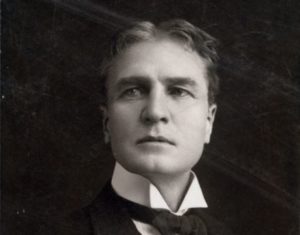
William Gillette’s Last Performance – Today in History: February 27
On February 27, 1936, William Gillette made his last appearance on any Connecticut stage at the Bushnell Memorial auditorium in Hartford.
Read
Timothy Dwight Dies – Today in History: January 11
On January 11, 1817, Timothy Dwight (theologian, educator, poet, and eighth president of Yale) died in New Haven, Connecticut.
Read
Ebenezer Tracy Made Some of the Finest 18th-Century Furniture
Ebenezer Tracy was a carpenter from Lisbon, Connecticut, who specialized in making fine, hand-crafted furniture.
Read
Creative License, or Fundamental Fact?
In 1973, the state legislature mandated that Connecticut’s license plates should display the state slogan “Constitution State.”
Read
Benjamin Silliman and the Collection That Inspired the Yale Peabody Museum
Benjamin Silliman published the first American study of a meteor—having acquired access to one that fell near the town of Weston.
Read
Why Was New Haven Divided into Nine Squares?
The layout of New Haven’s nine-square grid, though not the plan itself, is attributed to the original settlers’ surveyor, John Brockett.
Read
The Connecticut History Sports Challenge
Can you pass the Connecticut History Sports Challenge?
Read
Mohegan Federal Recognition
“We are no longer the little old tribe that lives upon the hill. We are now the Nation that lives upon the hill.”
Read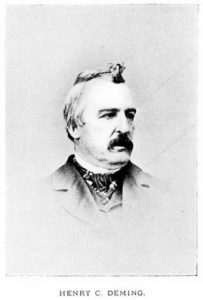
Henry Deming: Mayor of Hartford and New Orleans
Henry Deming served as mayor of Hartford and then as the provisional mayor of New Orleans during the Civil War before writing a biography of Ulysses S. Grant.
Read
A Fair to Forget – Who Knew?
In 1899, the citizens of Danbury petitioned the State Law and Order League to have detectives present at the Danbury Fair to monitor banned activities.
Read
Map – Connecticut Landmarks of the Constitution
A map of some of the Connecticut Landmarks of the Constitution researched and published by the Connecticut Trust for Historic Preservation.
Read
Labor Day at the Turn of the 20th Century
In February of 1889, the Connecticut General Assembly passed a bill making the first Monday of each September a legal holiday.
Read
Killingworth’s Automated Attraction – Who Knew?
In the 1890s Clark Coe created an attraction of life-sized moving figures called the Killingworth Images on his farm on Green Hill Road.
Read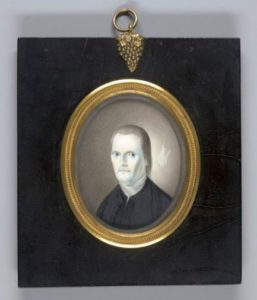
A Remarkable Signature – Who Knew?
Roger Sherman, Connecticut merchant, lawyer, and statesman, was the only person to sign all four documents of the American Revolution.
Read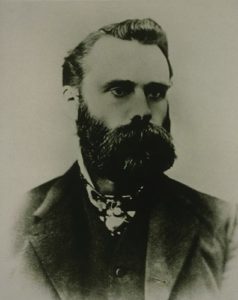
Humble Beginnings of the Dow Jones: How a Sterling Farmer Became the Toast of Wall Street
The life of Charles Dow, in many respects, follows the storyline of the prototypical self-made man.
Read
Mounds Candy Bar Involved in Espionage – Who Knew?
A storied Naugatuck business had its own “navy” and that it performed espionage services for the United States government during World War II.
Read
Samuel Waldo Born – Today in History: April 6
Samuel Lovett Waldo was an early 19th-century portrait artist who worked among such famous colleagues as John Trumbull, Benjamin West, and John Singleton Copley.
Read
Benjamin Silliman and Soda Water – Who Knew?
Yale’s first professor of chemistry, Benjamin Silliman, was also the first American to produce soda water in bulk.
Read
The Story Trail of Voices
Mohegan history and religion have been preserved by many different voices in many different families through Mohegan Oral Tradition. However, since before the American Revolution, four women in particular have passed on Mohegan stories.
Read
A Voice for Veterans: A Civil War era ‘Whistle-Blower’ – Who Knew?
Her obituary stated that “Mrs. Ambler was always expected to say something” on behalf of those who had fought for the Union.
Read
Providing Bundles for Britain and News for America
Janet Huntington Brewster Murrow was a Middletown native who grew up to be one of America’s most trusted news correspondents, philanthropists, and the wife of Edward R. Murrow.
Read
James Mars’ Words Illuminate the Cruelty of Slavery in New England
Mars’ landmark memoir of the mid-1800s reveals how enslaved men and women suffered—and resisted—the injustices of bondage.
Read
Venture Smith, from Slavery to Freedom
Smith’s account sheds light on the experience of enslaved and free blacks in 18th-century Connecticut.
Read
History in a Heart
A set of old Valentine’s Day cards, kept safe in a cloth-covered scrapbook, provide a look back at the sometimes humorous art of expressing heartfelt sentiments.
Read
Edward Alexander Bouchet: The First African American to Earn a PhD from an American University
Edward Alexander Bouchet was a physicist who was among Yale’s first African American students, and reportedly became the first African American in the United States to earn a PhD.
Read
Uriah Tracy Authors the Rules for Impeachment
Uriah Tracy was an attorney and politician who took up arms against the British after the Battles of Lexington and Concord.
Read
William Douglas: A Colonial Hero’s Sacrifice
William Douglas was a successful merchant and military leader who settled in North Branford just prior to the Revolutionary War.
Read
Patents – Bozrah’s Inventive Minds
From the time the federal government first began issuing patents in 1790, Connecticut was a national leader in patenting its abundant innovations.
Read
“Tom Thumb” Born – Today in History: January 4
Charles Stratton, born in Bridgeport on January 4, 1838, toured the world with P. T. Barnum under the name, General Tom Thumb.
Read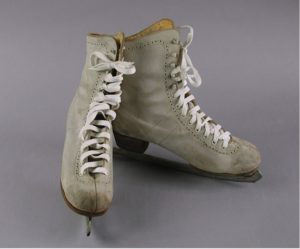
Skating Through Winter
By the 1850s, better-designed skates and interest in healthful outdoor activities made ice skating an increasingly popular leisure activity.
Read
Chief G’tinemong/Ralph W. Sturges
This Mohegan Chief is remembered for successfully guiding the Tribe through the final stages of Federal Recognition, which it obtained in 1994.
Read
Waterbury Clock Company Saved by Mickey Mouse – Who Knew?
The Ingersoll Waterbury Company (now Timex) was saved from bankruptcy during the Great Depression, in part, by the introduction of the Mickey Mouse watch.
Read
Elihu Burritt Born – Today in History: December 8
On December 8, 1810, Elihu Burritt was born in New Britain, Connecticut, to a farming family and became a leading pacifist of his time.
Read
Reporting News of Pearl Harbor – Today in History: December 7
On December 7, 1941, Mansfield resident and UConn history professor Andre Schenker took to the airwaves to report on the attack on Pearl Harbor.
Read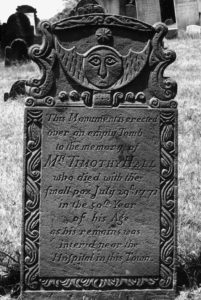
The Pest House Completed – Today in History: December 4
On December 4, 1760, the town of Durham announced the completion of their hospital house, precipitated by an outbreak of smallpox the year before.
Read
The White Pine Acts – Who Knew?
The British government made it illegal for colonials to cut down white pine trees over 24 inches in diameter—preserving the trees for use as masts on British naval ships.
Read
Video: 1938 Thanksgiving Proclamation
Connecticut Governor Wilbur L. Cross reading his 1938 Thanksgiving Proclamation to his cabinet. This was the first sound film ever made featuring a Governor of Connecticut.
Read
Emile Gauvreau and the Era of Tabloid Journalism
Emile Gauvreau, former managing editor of the Hartford Courant, became a pioneer in the rise of tabloid journalism.
Read
Daniel Curtiss: The Life of a 19th-Century Self-Made Man
Daniel Curtiss spent most of his life in Woodbury, thriving in business, pioneering the sale and distribution of commercial goods, and serving his town by holding political office.
Read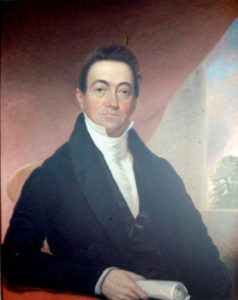
Samuel Foot: A Trader Turned Governor
Samuel Foot was a West India trader from Cheshire, Connecticut, who went on to a successful career in politics in the US Congress.
Read
The “Red Scare” in Connecticut
The Palmer Raids, launched in Connecticut in 1919, were part of the “Red Scare” paranoia that resulted in numerous civil rights violations committed by law enforcement officials.
Read
Video – The Hindenburg Flies Over Hartford
This video, taken in October of 1936, shows the Hindenburg sailing over Hartford, a short seven months before its destruction.
Read
Evelyn Beatrice Longman Commemorates the Working Class
“Industry,” also known as “The Craftsman,” by Evelyn Longman, resides in Hartford and is a celebration of the working class and their contribution to society.
Read
The Child’s Picture Defining and Reading Book by Thomas Hopkins Gallaudet
Thomas Hopkins Gallaudet The Child’s Picture Defining and Reading Book in 1830 while the principal of the American School for the Deaf in Hartford.
Read
Hartford Wide-Awakes – Today in History: July 26
On July 26, 1860, the Hartford Wide-Awakes welcomed the Newark, New Jersey, Wide-Awakes to a banquet and ratification meeting at Hartford’s City Hall.
Read
Mohegan Sacred Sites: Moshup’s Rock
Every nation has a spirit. The Mohegan Spirit moves and breathes within the very rocks and trees of the Mohegan Homeland in Uncasville, Connecticut.
Read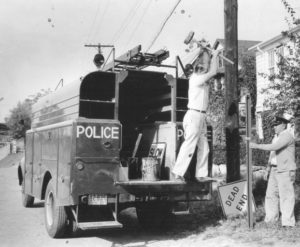
Greenwich Emergency Responders: On the Move Overtime
Horses, motorcycles, and boats are just a few of the modes of transportation that town emergency personnel have used over the years to get to where they’re needed.
Read
North Haven: Fabricating Sculpture in the 1960s and 1970s
Lippincott, Inc., in North Haven, was one of the most highly respected fine-arts metal fabricators in the country in the second half of the 20th century.
Read
The Platt Amendment – Today in History: June 12
Orville Platt from Meriden presented the Platt Amendment to Congress in 1901. It essentially made Cuba an American protectorate.
Read
Timeline: Settlement of the Colony of Connecticut
A timeline displaying the major events leading to Connecticut statehood, including its settlement by the Dutch, the origins of Hartford, Wethersfield, and Windsor, the founding of the Connecticut, New Haven, and Saybrook colonies, and Connecticut’s acquisition of a formal charter from England.
Read
The Inventive Minds of Connecticut Women: Patents in the 19th Century
Between 1790 and 1930, Connecticut residents were issued the most patents in the US per capita, many of them inventions by women.
Read
First Woman Elected as US State Governor Born – Today in History: May 10
On May 10, 1919, Ella Grasso, née Ella Rosa Giovanna Oliva Tambussi, the first woman governor in the US to be elected “in her own right,” was born in Windsor Locks.
Read
Vietnam Veterans Against the War – Today in History: April 19
On April 19, 1971, Vietnam veterans groups from Hartford, New Haven, and Stamford joined demonstrations in Washington, DC.
Read
Litchfield’s Revolutionary War Soldiers’ Tree
In 1902, the Daughters of the American Revolution celebrated Arbor Day by planting a tree on the Litchfield Green to commemorate the town’s Revolutionary War soldiers.
Read
Anna Elizabeth Dickinson at Touro Hall – Today in History: March 24
On March 24, 1863, Anna Elizabeth Dickinson, a 20-year-old Quaker and abolitionist from Pennsylvania, spoke at Hartford’s Touro Hall.
Read
Hilda Crosby Standish, Early Proponent of Women’s Reproductive Health
A pioneer of sex education and family planning, this physician directed the state’s first birth control clinic in 1935.
Read
The Telescoping Fishing Rod – Today in History: March 8
On March 8, 1887, Everett Horton, a Bristol mechanic, patented a fishing rod of telescoping steel tubes.
Read
Elihu Burritt Dies – Today in History: March 6
On March 6, 1879, Elihu Burritt “the learned blacksmith” died in New Britain.
Read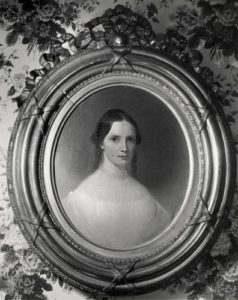
Looking Back: Tempest Tossed, the Story of Isabella Beecher Hooker
Isabella Beecher was a suffragist and spiritualist who shunned traditional female roles while alienating large parts of her family during her brother’s adultery scandal.
Read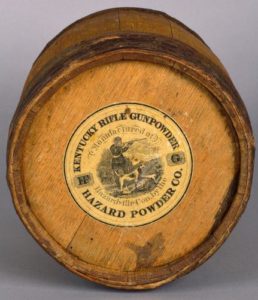
One-Legged Stools – Who Knew?
Hazard Powder Company employees sat on one-legged stools to keep them from falling asleep while working with dangerous materials.
Read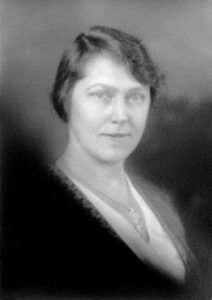
Dr. E. Irene Boardman Never Stopped Serving the Public
Having suffered from polio as a child, Emma Irene Boardman found her calling in relieving the pain of others.
Read
Lounsbury Elected Governor – Today in History: January 4
On January 4th 1899, George Edward Lounsbury was elected the 58th Governor of Connecticut, for which he served roughly three years.
Read
Hamden’s Literary Legend
Thornton Wilder, author of such renowned works as Our Town, The Matchmaker, and The Bridge of San Luis Rey, lived in Hamden for much of his life.
Read
Just Pour Over Ice – Who Knew?
The Heublein Restaurant served its thirsty customers pre-mixed cocktails that became so wildly popular they had to build a distillery just to meet demand.
Read
A Connecticut Nazi Spy Has a Change of Heart
A Connecticut-born Nazi spy, William Colepaugh, had a change of heart and turned himself in to the FBI on December 26, 1944.
Read
New Haven: What Was Everyday Life Like During the Civil War?
A great primary resource for digging into a community’s everyday life is a city directory.
Read
A Day of Celebration – Today in History: September 17
September 17, 1879 was a day of celebration in the City of Hartford when more than 100,000 people came to the city to celebrate Battle Flag Day.
Read
State Heroine Prudence Crandall
Prudence Crandall was born in 1803 in Hopkinton, Rhode Island, the daughter of Quaker parents.
Read
Halladay’s Revolutionary Windmill – Today in History: August 29
On August 29, 1854, Daniel Halladay a machinist, inventor, and businessman patented the first commercially viable windmill—Halladay’s Self-Governing Windmill.
Read
Eighteen-hundred-and-froze-to-death: 1816, The Year Without a Summer
Sunspots and volcanic eruptions led to cooler than normal temperatures in the summer of 1816.
Read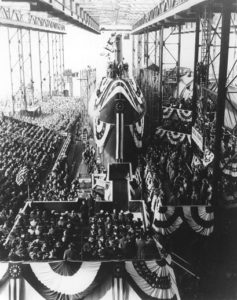
Launching of the USS Nautilus 1954
The building of the Nautilus helped Groton sustain its title of “Submarine Building Capital of the World.”
Read
The Hartford Wits
Eventually taking the name the “Hartford Wits,” influential figures of the 18th century got together to write poetry that documented the state of the times.
Read
Furniture Caster Patented – Today in History: June 30
On June 30, 1838, the US patent No. 821—the first for a furniture caster—was granted to the Blake Brothers of New Haven.
Read
Uncle Tom’s Cabin Begins Serialization – Today in History: June 5
On June 5, 1851, the first chapter of what became the landmark novel Uncle Tom’s Cabin appeared in the National Era, an anti-slavery newspaper in Washington, DC.
Read
Dark Day – Today in History: May 19
On May 19, 1780, a strange darkness fell over much of New England. The darkness that enveloped Connecticut remained there for a day and a half.
Read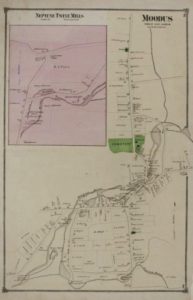
Largest Earthquake in Connecticut – Today in History: May 16
On May 16, 1791, the largest earthquake to shake Connecticut took place in Moodus, an area known for earthquake activity.
Read
The British Attack Danbury – Today in History: April 26
On April 25, 1777, British forces land at the mouth of the Saugatuck River with plans to attack Danbury.
Read
An Orderly and Decent Government
An Orderly and Decent Government is an exhibition on the history of representative government in Connecticut developed by the CT Humanities in April 2000.
Read
A Real Connecticut Yankee’s Baseball Career Cut Short
An up-and-coming baseball star discovered playing on the lots of Collinsville, Danny Hoffman played in the majors before joining the New York Yankees.
Read
Connecticut: Home to the Boxcar Children Mysteries – Who Knew?
…that Gertrude Chandler Warner, a lifelong resident of Putnam, Connecticut, authored the popular series The Boxcar Children Mysteries?
Read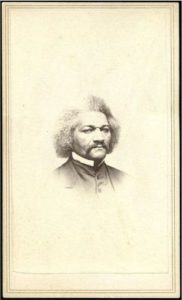
Speaking under the Open Sky: Frederick Douglass in Connecticut
The famous abolitionist Frederick Douglass had several connections to Connecticut, including run-ins with a number of the state’s vocal slavery proponents.
Read
The Innumerable Accolades Afforded Dr. William H. Welch
Trained at Yale, William Welch was a native of Norfolk, Connecticut, and one of the most celebrated physicians of his time.
Read
Freighter Worcester Launched – Today in History: April 5
On April 5, 1919, the freighter Worcester was launched in Groton in support of the war effort for the Emergency Fleet Corporation of the US Shipping Board.
Read
Forgotten Founder: John Davenport of New Haven
John Davenport, the founder of New Haven, was a prominent Puritan leader during the early years of the New England colonies.
Read
Video – Sophie Tucker Tribute Film
The Connecticut Women’s Hall of Fame pays tribute to celebrated singer and actress, and long-time Hartford resident, Sophie Tucker.
Read
A Candy Bar Empire in Naugatuck
Almond Joy and Mounds were two of the most popular candy bars sold by Naugatuck’s Peter Paul Manufacturing Company, an enterprise begun by Armenian immigrant Peter Halajian.
Read
Video – Emily Dunning Barringer Tribute Film
The Connecticut Women’s Hall of Fame pays tribute to long-time New Canaan resident, Dr. Emily Barringer, the first female ambulance surgeon and first female physician in the nation to secure a surgical residency.
Read
Connecticut Suffragists 1919
Despite the fact that the women in this well-known photograph are unidentified, Connecticut was home to many important figures in women’s struggle for equal rights.
Read
Leatherman Dies – Today in History: March 20
On March 20, 1889, the Old Leatherman, so called for the clothing that he fashioned for himself, is thought to have died.
Read
Gideon Welles Appointed Lincoln’s Secretary of the Navy – Today in History: March 7
On March 7, 1861 Gideon Welles was officially appointed into Abraham Lincoln’s cabinet as Secretary of the Navy.
Read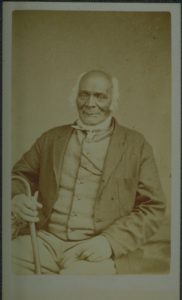
1850s Equal Rights Activist James Mars
James Mars became one of the most prominent African Americans in the region, and a leader of Hartford’s African American community.
Read
Hartford Times – Voices of Change
1960’s photographs from The Hartford Times offer a look back at a decade of protest that focused local and national attention on the civil rights of African Americans, the war in Vietnam, and the inequalities facing women.
Read
Charles McLean Andrews and Evangeline Walker Andrews
Charles McLean Andrews was one of the most distinguished historians of his time, generally recognized as the master of American colonial history.
Read
Video – Undersea University – US Navy’s Submarine School
1965 film of the US Naval Submarine Base New London submarine training school produced by the US government.
Read
Noble Jerome’s Clock Patent Model
Noble Jerome submitted this clock patent model to the US Patent Office along with his patent application in 1839, a common requirement up until the 1880s.
Read
P. T. Barnum Dies – Today in History: April 7
On April 7, 1891, the showman and entertainer, P. T. (Phineas Taylor) Barnum died in Bridgeport.
Read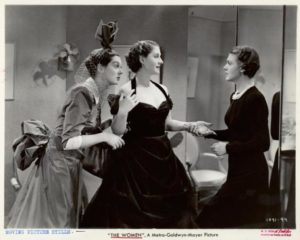
Video – Rosalind Russell Tribute Film
Connecticut Women’s Hall of Fame pays tribute to Waterbury native Rosalind Russell, the legendary award-winning actress of stage and screen.
Read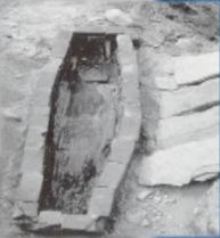
Video – Vampires and Witches in Connecticut a Lecture and Panel Discussion
Explore Connecticut’s aggressive prosecution and execution of accused witches between 1647 and 1663, decades before the famous Salem witch trials.
Read
Waterbury Tornado – Today in History: May 24
On May 24, 1962, a tornado hit the towns of Waterbury, Wolcott, and Southington.
Read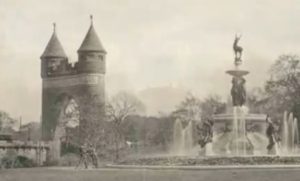

Patents – Stafford’s Inventive Minds
Starting in 1790, Connecticut became a national leader in obtaining patents for its abundant innovations. It not only led the nation in patents issued per capita, but in 1809, South Killingly resident Mary Kies became the first woman awarded a US patent.
Read
Video – Unsung Heroes: The Music of Jazz in New Haven
This documentary clip showcases the heritage of New Haven’s jazz community, weaving the personal narrative of musicians and their families within the context of the city’s social and political history.
Read
Patents – Bloomfield’s Inventive Minds
From the time the federal government first began issuing patents in 1790, Connecticut was a national leader in patenting its abundant innovations.
Read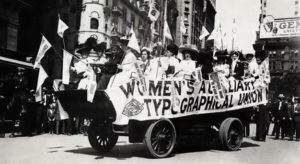
Video – Augusta Lewis Troup Tribute Film
The Connecticut Women’s Hall of Fame pays tribute to Augusta Lewis Troup, a pioneering labor leader, journalist, educator, and suffragist.
Read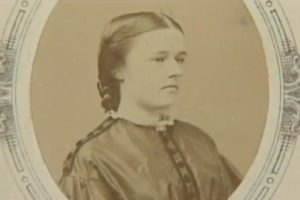
Video – Dotha Bushnell Hillyer Tribute Film
The Connecticut Women’s Hall of Fame pays tribute to philanthropist Dotha Bushnell Hillyer, patron of a living memorial to her father, the Reverend Horace Bushnell.
Read
Video – Helen Keller Tribute Film
The Connecticut Women’s Hall of Fame pays tribute to Easton resident Helen Keller, an inspirational champion for the disabled.
Read
Video – Florence Wald Tribute Film
The Connecticut Women’s Hall of Fame pays tribute to Florence Wald, founder of hospice care in the United States.
Read
Video – Barbara McClintock Tribute Film
The Connecticut Women’s Hall of Fame pays tribute to Hartford native Barbara McClintock, a famed geneticist and Nobel Prize winner.
Read
Video – When Disaster Struck: The Flood of 1936, Part I
The CPTV Original, When Disaster Struck Connecticut, provides an in-depth look at the four major natural disasters that befell Connecticut between 1888 and 1955.
Read
Video – When Disaster Struck: The Flood of 1936, Part 2
The CPTV Original, When Disaster Struck Connecticut, provides an in-depth look at the four major natural disasters that befell Connecticut between 1888 and 1955.
Read
Video – When Disaster Struck: King Blizzard
The CPTV Original, When Disaster Struck Connecticut, provides an in-depth look at the four major natural disasters that befell Connecticut between 1888 and 1955.
Read
Video – Mary Townsend Seymour Tribute Film
Connecticut Women’s Hall of Fame pays tribute to Hartford native Mary Townsend Seymour, a pioneering advocate for equal rights for African Americans and co-founder of Hartford’s chapter of the NAACP.
Read
Video – Florence Griswold Tribute Film
The Connecticut Women’s Hall of Fame pays tribute to Florence Griswold, an Old Lyme native who fostered the impressionist art movement in Connecticut.
Read
Oldies But Goodies – Order DVDs from the Vaults of the Connecticut Humanities
YouTube – CTHPrograms – Co-produced by Connecticut Public Television and…
Read
Video – Connecticut’s Cultural Treasures: American Clock & Watch Museum
Connecticut’s Cultural Treasures is a series of 50 five-minute film vignettes that profiles a variety of the state’s most notable cultural resources.
Read
Over Time: West Hartford’s Historical Population
Census data, from colonial times on up to the present, is a key resource for those who study the ways in which communities change with the passage of time.
Read
Video: No Booze for You – Who Knew?
During Prohibition, many Connecticut residents found it easy to obtain alcohol illegally, though violations of Prohibition led to an increase in violent crime.
Read
Video – When Disaster Struck: The 1938 Hurricane, Part I
The CPTV Original, When Disaster Struck Connecticut, provides an in-depth look at the four major natural disasters that befell Connecticut between 1888 and 1955.
Read
The Forlorn Soldier
The Forlorn Soldier, a statue by James G. Batterson, survived years of neglect, punishing weather, and movements to tear it down, and yet still serves an important purpose in Civil War commemoration.
Read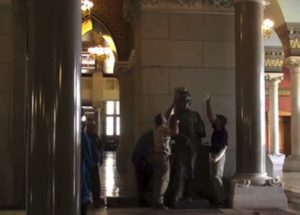
A Soldier’s Welcome
In September of 2013, officials arranged for the statue of the Forlorn Soldier to be placed in its new permanent home at the Connecticut State Capitol.
Read
Video – William Gillette’s Railroad
Actor William Gillette is featured in this two-minute newsreel, “Sherlock Holmes Turns Engineer,” filmed by Fox Movietone News in 1927.
Read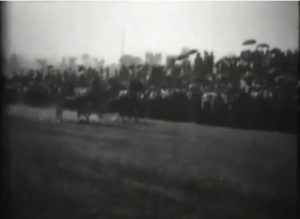
Video – Free-for-all Race at Charter Oak Park
A crowd of some 25,000 to 30,000 people turned out to see John R. Gentry compete for a $6,000 purse.
Read
Nathan Starr’s Cutlass Fought the War of 1812
On May 18, 1808, the Navy Agent Joseph Hull of New London negotiated a contract with Nathan Starr of Middletown for 2,000 cutlasses.
Read
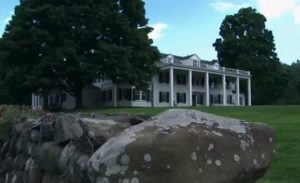
Video – Connecticut’s Cultural Treasures: Hill-Stead Museum
Connecticut’s Cultural Treasures is a series of 50 five-minute film vignettes that profiles a variety of the state’s most notable cultural resources.
Read
Video – Connecticut’s Cultural Treasures: Webb-Deane-Stevens Museum
Connecticut’s Cultural Treasures is a series of 50 five-minute film vignettes that profiles a variety of the state’s most notable cultural resources.
Read
Video – Rudolph Zallinger’s Masterpiece, “The Age of Reptiles”
The Yale Peabody Museum is home to one of the world’s largest murals, which illustrates changes in the earth’s flora and fauna between the Devonian and Cretaceous periods.
Read
Video – Martha Parsons Tribute Film
The Connecticut Women’s Hall of Fame pays tribute to Enfield native Martha Parsons, the first female business executive in Connecticut to earn her position based on merit.
Read
Video – Haunted History: Harriet Beecher Stowe House
Your Town’s History in Video: Harriet Beecher Stowe House
Read
Video – Home Front: Connecticut During World War II – Migration and Housing
This excerpt from the Connecticut Experience series provides a glimpse into the people, places, and events that have shaped our state’s history.
Read
Harriet Beecher Stowe, Uncle Tom’s Cabin Published 1852
Harriet Beecher Stowe’s most famous book is Uncle Tom’s Cabin, which was published in 1852.
Read
Over Time: Redding’s Historical Population
Census data, from colonial times on up to the present, is a key resource for those who study the ways in which communities change with the passage of time.
Read
Over Time: Ridgefield’s Historical Population
Census data, from colonial times on up to the present, is a key resource for those who study the ways in which communities change with the passage of time.
Read
Video – Mark Twain at Stormfield
This rare footage is thought to be the only film of famed author Samuel Clemens.
Read
Over Time: Orange’s Historical Population
Census data, from colonial times on up to the present, is a key resource for those who study the ways in which communities change with the passage of time.
Read
Over Time: Newtown’s Historical Population
Census data, from colonial times on up to the present, is a key resource for those who study the ways in which communities change with the passage of time.
Read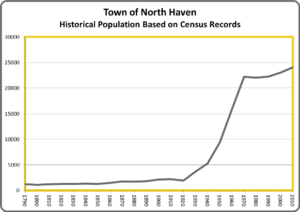
Over Time: North Haven’s Historical Population
Census data, from colonial times on up to the present, is a key resource for those who study the ways in which communities change with the passage of time.
Read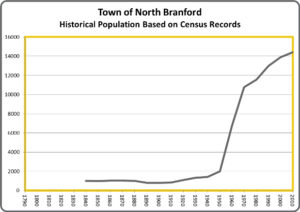
Over Time: North Branford’s Historical Population
Census data, from colonial times on up to the present, is a key resource for those who study the ways in which communities change with the passage of time.
Read
Over Time: Greenwich’s Historical Population
Census data, from colonial times on up to the present, is a key resource for those who study the ways in which communities change with the passage of time.
Read
Over Time: Darien’s Historical Population
Census data, from colonial times on up to the present, is a key resource for those who study the ways in which communities change with the passage of time.
Read
Over Time: New Fairfield’s Historical Population
Census data, from colonial times on up to the present, is a key resource for those who study the ways in which communities change with the passage of time.
Read
Products from New Britain’s Past
In the early 20th century, New Britain produced a variety of housewares popular with the American public, including cutlery, toasters, waffle irons, pocketknives, food choppers, and eggbeaters.
Read
Over Time: East Haven’s Historical Population
Census data, from colonial times on up to the present, is a key resource for those who study the ways in which communities change with the passage of time.
Read
Over Time: New Canaan’s Historical Population
Census data, from colonial times on up to the present, is a key resource for those who study the ways in which communities change with the passage of time.
Read
Over Time: Easton’s Historical Population
Census data, from colonial times on up to the present, is a key resource for those who study the ways in which communities change with the passage of time.
Read
Charles Goodyear and the Vulcanization of Rubber
Obsessive dedication transformed rubber into a viable commercial material and made the town of Naugatuck one of its leading manufacturing sites in the 1800s.
Read
Over Time: Milford’s Historical Population
Census data, from colonial times on up to the present, is a key resource for those who study the ways in which communities change with the passage of time.
Read
Over Time: New Haven’s Historical Population
Census data, from colonial times on up to the present, is a key resource for those who study the ways in which communities change with the passage of time.
Read
Standing at Rest, at Last: The Story of the Forlorn Soldier
This story takes a look at the statue’s history, its care, conservation, and journey to the Connecticut State Capitol building where the Forlorn Soldier stands in all its glory.
Read
Over Time: Derby’s Historical Population
Census data, from colonial times on up to the present, is a key resource for those who study the ways in which communities change with the passage of time.
Read
Over Time: West Haven’s Historical Population
Census data, from colonial times on up to the present, is a key resource for those who study the ways in which communities change with the passage of time.
Read
Over Time: Danbury’s Historical Population
Census data, from colonial times on up to the present, is a key resource for those who study the ways in which communities change with the passage of time.
Read
Over Time: Shelton’s Historical Population
Census data, from colonial times on up to the present, is a key resource for those who study the ways in which communities change with the passage of time.
Read
Free Speech for Some – Who Knew?
In 1939, 150 years after the original passage, Connecticut finally ratified the US Bill of Rights, guaranteeing workers the right to free speech.
Read
American Chairs, Made in Connecticut
While the Windsor chair’s style and manufacture emerged in England in the early 1700s, it became extremely popular in North America during the 18th and 19th centuries.
Read
Civil War Monuments and Memorials in and Around the State Capitol
Monuments and memorials from the Civil War era in and around the state capitol in Hartford, Connecticut.
Read
Sunday Funday? We Think Not – Who Knew?
At the start of the 20th century, authorities banned Luna Park in West Hartford from operating on Sundays, as it defied long-standing puritan laws.
Read
Over Time: Stamford’s Historical Population
Census data, from colonial times on up to the present, is a key resource for those who study the ways in which communities change with the passage of time.
Read
Over Time: Norwalk’s Historical Population
Census data, from colonial times on up to the present, is a key resource for those who study the ways in which communities change with the passage of time.
Read
Forlorn Soldier Oral History Interviews
Oral histories make up a substantial portion of our knowledge regarding the Forlorn Soldier.
Read
The Legend of Old Hayfoot, the Forlorn Soldier
A 1932 Hartford Courant report helped perpetuate a legend about the Forlorn Soldier, a Civil War statue designed with a nontraditional right-foot-forward stance many thought to be a mistake.
Read
The Forlorn Soldier Conservation Ceremony, July 2013
Originally located on Charter Oak Avenue, the statue of the Forlorn Soldier moved to Airport Road in the spring of 1968, after ConservArt worked to repair and restore the statue.
Read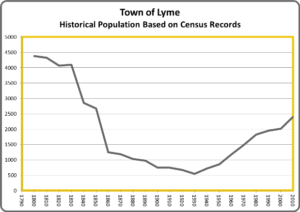
Over Time: Lyme’s Historical Population
Census data, from colonial times on up to the present, is a key resource for those who study the ways in which communities change with the passage of time.
Read
Video: The Story of the Salisbury Iron District
Connecticut-made iron was extraordinarily high quality and sought after.
Read
Over Time: Norwich’s Historical Population
Census data, from colonial times on up to the present, is a key resource for those who study the ways in which communities change with the passage of time.
Read
Over Time: Old Saybrook’s Historical Population
Census data, from colonial times on up to the present, is a key resource for those who study the ways in which communities change with the passage of time.
Read
Over Time: Preston’s Historical Population
Census data, from colonial times on up to the present, is a key resource for those who study the ways in which communities change with the passage of time.
Read
Over Time: Clinton’s Historical Population
Census data, from colonial times on up to the present, is a key resource for those who study the ways in which communities change with the passage of time.
Read
Over Time: Bridgeport’s Historical Population
Census data, from colonial times on up to the present, is a key resource for those who study the ways in which communities change with the passage of time.
Read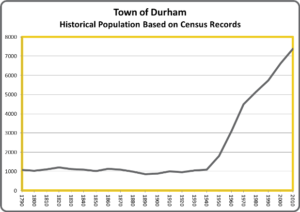
Over Time: Durham’s Historical Population
Census data, from colonial times on up to the present, is a key resource for those who study the ways in which communities change with the passage of time.
Read
Over Time: Bethel’s Historical Population
Census data, from colonial times on up to the present, is a key resource for those who study the ways in which communities change with the passage of time.
Read
Over Time: Old Lyme’s Historical Population
Census data, from colonial times on up to the present, is a key resource for those who study the ways in which communities change with the passage of time.
Read
Over Time: Branford’s Historical Population
Census data, from colonial times on up to the present, is a key resource for those who study the ways in which communities change with the passage of time.
Read
Over Time: Brookfield’s Historical Population
Census data, from colonial times on up to the present, is a key resource for those who study the ways in which communities change with the passage of time.
Read
William Edgar Simonds: A Schoolteacher Turned Civil War Hero
Originally a teacher, William Edgar Simonds’ service during the Civil War launched Simonds into a life of politics and international acclaim.
Read
Over Time: Bristol’s Historical Population
Census data, from colonial times on up to the present, is a key resource for those who study the ways in which communities change with the passage of time.
Read
Over Time: Wolcott’s Historical Population
Census data, from colonial times on up to the present, is a key resource for those who study the ways in which communities change with the passage of time.
Read
Over Time: Plymouth’s Historical Population
Census data, from colonial times on up to the present, is a key resource for those who study the ways in which communities change with the passage of time.
Read
Elias Perkins: One of Lisbon’s Most Accomplished Public Servants
Elias Perkins’s career in public service lasted nearly half a century and made him a popular figure both locally and nationally.
Read
Over Time: Westbrook’s Historical Population
Census data, from colonial times on up to the present, is a key resource for those who study the ways in which communities change with the passage of time.
Read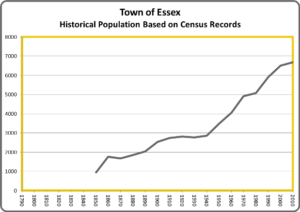
Over Time: Essex’s Historical Population
Census data, from colonial times on up to the present, is a key resource for those who study the ways in which communities change with the passage of time.
Read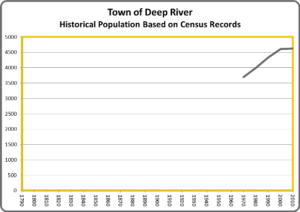
Over Time: Deep River’s Historical Population
Census data, from colonial times on up to the present, is a key resource for those who study the ways in which communities change with the passage of time.
Read
Over Time: Chester’s Historical Population
Census data, from colonial times on up to the present, is a key resource for those who study the ways in which communities change with the passage of time.
Read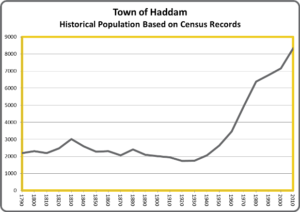
Over Time: Haddam’s Historical Population
Census data, from colonial times on up to the present, is a key resource for those who study the ways in which communities change with the passage of time.
Read
Over Time: East Haddam’s Historical Population
Census data, from colonial times on up to the present, is a key resource for those who study the ways in which communities change with the passage of time.
Read
Over Time: Salem’s Historical Population
Census data, from colonial times on up to the present, is a key resource for those who study the ways in which communities change with the passage of time.
Read
Over Time: East Lyme’s Historical Population
Census data, from colonial times on up to the present, is a key resource for those who study the ways in which communities change with the passage of time.
Read
Over Time: Waterford’s Historical Population
Census data, from colonial times on up to the present, is a key resource for those who study the ways in which communities change with the passage of time.
Read
Over Time: New London’s Historical Population
Census data, from colonial times on up to the present, is a key resource for those who study the ways in which communities change with the passage of time.
Read
Over Time: Montville’s Historical Population
Census data, from colonial times on up to the present, is a key resource for those who study the ways in which communities change with the passage of time.
Read
Over Time: Groton’s Historical Population
Census data, from colonial times on up to the present, is a key resource for those who study the ways in which communities change with the passage of time.
Read
Over Time: Stonington’s Historical Population
Census data, from colonial times on up to the present, is a key resource for those who study the ways in which communities change with the passage of time.
Read
Over Time: Ledyard’s Historical Population
Census data, from colonial times on up to the present, is a key resource for those who study the ways in which communities change with the passage of time.
Read
Over Time: North Stonington’s Historical Population
Census data, from colonial times on up to the present, is a key resource for those who study the ways in which communities change with the passage of time.
Read
Over Time: Griswold’s Historical Population
Census data, from colonial times on up to the present, is a key resource for those who study the ways in which communities change with the passage of time.
Read
Over Time: Voluntown’s Historical Population
Census data, from colonial times on up to the present, is a key resource for those who study the ways in which communities change with the passage of time.
Read
Over Time: Windham’s Historical Population
Census data, from colonial times on up to the present, is a key resource for those who study the ways in which communities change with the passage of time.
Read
Over Time: Marlborough’s Historical Population
Census data, from colonial times on up to the present, is a key resource for those who study the ways in which communities change with the passage of time.
Read
Over Time: Woodstock’s Historical Population
Census data, from colonial times on up to the present, is a key resource for those who study the ways in which communities change with the passage of time.
Read
Over Time: Eastford’s Historical Population
Census data, from colonial times on up to the present, is a key resource for those who study the ways in which communities change with the passage of time.
Read
Over Time: Franklin’s Historical Population
Census data, from colonial times on up to the present, is a key resource for those who study the ways in which communities change with the passage of time.
Read
Over Time: Somers’ Historical Population
Census data, from colonial times on up to the present, is a key resource for those who study the ways in which communities change with the passage of time.
Read
Over Time: Lebanon’s Historical Population
Census data, from colonial times on up to the present, is a key resource for those who study the ways in which communities change with the passage of time.
Read
Over Time: Union’s Historical Population
Census data, from colonial times on up to the present, is a key resource for those who study the ways in which communities change with the passage of time.
Read
Over Time: Willington’s Historical Population
Census data, from colonial times on up to the present, is a key resource for those who study the ways in which communities change with the passage of time.
Read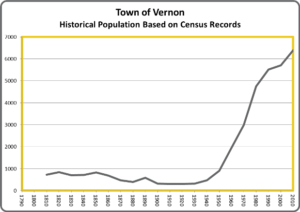
Over Time: Vernon’s Historical Population
Census data, from colonial times on up to the present, is a key resource for those who study the ways in which communities change with the passage of time.
Read
Over Time: Pomfret’s Historical Population
Census data, from colonial times on up to the present, is a key resource for those who study the ways in which communities change with the passage of time.
Read
Over Time: Lisbon’s Historical Population
Census data, from colonial times on up to the present, is a key resource for those who study the ways in which communities change with the passage of time.
Read
Over Time: Stafford’s Historical Population
Census data, from colonial times on up to the present, is a key resource for those who study the ways in which communities change with the passage of time.
Read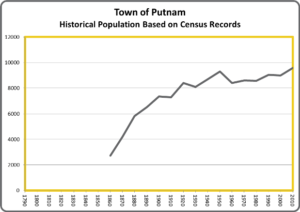
Over Time: Putnam’s Historical Population
Census data, from colonial times on up to the present, is a key resource for those who study the ways in which communities change with the passage of time.
Read
Over Time: Ellington’s Historical Population
Census data, from colonial times on up to the present, is a key resource for those who study the ways in which communities change with the passage of time.
Read
Over Time: Thompson’s Historical Population
Census data, from colonial times on up to the present, is a key resource for those who study the ways in which communities change with the passage of time.
Read
Over Time: Tolland’s Historical Population
Census data, from colonial times on up to the present, is a key resource for those who study the ways in which communities change with the passage of time.
Read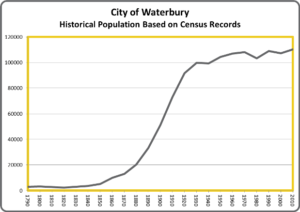
Over Time: Waterbury’s Historical Population
Census data, from colonial times on up to the present, is a key resource for those who study the ways in which communities change with the passage of time.
Read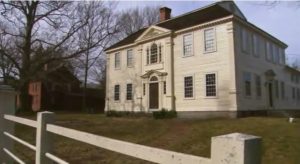
Video – Connecticut’s Cultural Treasures: Prudence Crandall Museum
Connecticut’s Cultural Treasures is a series of 50 five-minute film vignettes that profiles a variety of the state’s most notable cultural resources.
Read
Imagining Connecticut
Who are we? What traditions and accomplishments define us as a state and shape our lives today?
Read
Over Time: Killingworth’s Historical Population
Census data, from colonial times on up to the present, is a key resource for those who study the ways in which communities change with the passage of time.
Read
Over Time: Hamden’s Historical Population
Census data, from colonial times on up to the present, is a key resource for those who study the ways in which communities change with the passage of time.
Read
Over Time: Hampton’s Historical Population
Census data, from colonial times on up to the present, is a key resource for those who study the ways in which communities change with the passage of time.
Read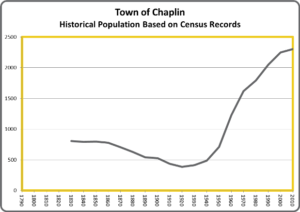
Over Time: Chaplin’s Historical Population
Census data, from colonial times on up to the present, is a key resource for those who study the ways in which communities change with the passage of time.
Read
Over Time: Plainfield’s Historical Population
Census data, from colonial times on up to the present, is a key resource for those who study the ways in which communities change with the passage of time.
Read
Over Time: Killingly’s Historical Population
Census data, from colonial times on up to the present, is a key resource for those who study the ways in which communities change with the passage of time.
Read
Over Time: Sterling’s Historical Population
Census data, from colonial times on up to the present, is a key resource for those who study the ways in which communities change with the passage of time.
Read
Over Time: Canterbury’s Historical Population
Census data, from colonial times on up to the present, is a key resource for those who study the ways in which communities change with the passage of time.
Read
Over Time: Fairfield’s Historical Population
Census data, from colonial times on up to the present, is a key resource for those who study the ways in which communities change with the passage of time.
Read
Over Time: Bolton’s Historical Population
Census data, from colonial times on up to the present, is a key resource for those who study the ways in which communities change with the passage of time.
Read
Over Time: Coventry’s Historical Population
Census data, from colonial times on up to the present, is a key resource for those who study the ways in which communities change with the passage of time.
Read
Over Time: Brooklyn’s Historical Population
Census data, from colonial times on up to the present, is a key resource for those who study the ways in which communities change with the passage of time.
Read
Over Time: Monroe’s Historical Population
Census data, from colonial times on up to the present, is a key resource for those who study the ways in which communities change with the passage of time.
Read
Over Time: Harwinton’s Historical Population
Census data, from colonial times on up to the present, is a key resource for those who study the ways in which communities change with the passage of time.
Read
Over Time: Guilford’s Historical Population
Census data, from colonial times on up to the present, is a key resource for those who study the ways in which communities change with the passage of time.
Read
Over Time: Madison’s Historical Population
Census data, from colonial times on up to the present, is a key resource for those who study the ways in which communities change with the passage of time.
Read
Over Time: Barkhamsted’s Historical Population
Census data, from colonial times on up to the present, is a key resource for those who study the ways in which communities change with the passage of time.
Read
Hidden Nearby: Jedediah Strong’s Milestone
The Litchfield man behind this colonial-era mile marker led an accomplished but, ultimately, tragic life.
Read
Over Time: Cheshire’s Historical Population
Census data, from colonial times on up to the present, is a key resource for those who study the ways in which communities change with the passage of time.
Read
Over Time: Bethany’s Historical Population
Census data, from colonial times on up to the present, is a key resource for those who study the ways in which communities change with the passage of time.
Read
Over Time: Hebron’s Historical Population
Census data, from colonial times on up to the present, is a key resource for those who study the ways in which communities change with the passage of time.
Read
Over Time: Prospect’s Historical Population
Census data, from colonial times on up to the present, is a key resource for those who study the ways in which communities change with the passage of time.
Read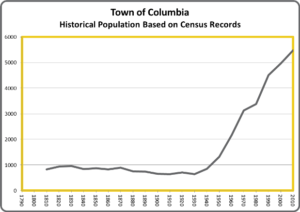
Over Time: Columbia’s Historical Population
Census data, from colonial times on up to the present, is a key resource for those who study the ways in which communities change with the passage of time.
Read
Over Time: Colchester’s Historical Population
Census data, from colonial times on up to the present, is a key resource for those who study the ways in which communities change with the passage of time.
Read
Over Time: Torrington’s Historical Population
Census data, from colonial times on up to the present, is a key resource for those who study the ways in which communities change with the passage of time.
Read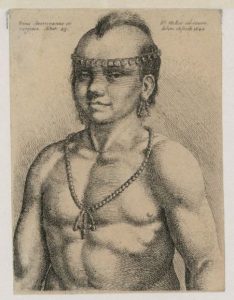
Algonquin Man 1645
The Native American presence in Connecticut represents an important part of our state’s heritage.
Read
Private Henry Cornwall 1862
Henry Cornwall was a member of the 20th Connecticut Infantry Volunteers. He served from September 8, 1862 to June 13, 1865.
Read
Mark Twain, Huckleberry Finn Published 1885
In 1874, after living in Hartford for three years, Samuel Clemens (Mark Twain) and his wife Olivia moved to a home in the area known as Nook Farm.
Read
Over Time: Woodbury’s Historical Population
Census data, from colonial times on up to the present, is a key resource for those who study the ways in which communities change with the passage of time.
Read
Over Time: Scotland’s Historical Population
Census data, from colonial times on up to the present, is a key resource for those who study the ways in which communities change with the passage of time.
Read
Over Time: Mansfield’s Historical Population
Census data, from colonial times on up to the present, is a key resource for those who study the ways in which communities change with the passage of time.
Read
Over Time: Sprague’s Historical Population
Census data, from colonial times on up to the present, is a key resource for those who study the ways in which communities change with the passage of time.
Read
Over Time: Bozrah’s Historical Population
Census data, from colonial times on up to the present, is a key resource for those who study the ways in which communities change with the passage of time.
ReadOver Time: Beacon Falls’ Historical Population
Census data, from colonial times on up to the present, is a key resource for those who study the ways in which communities change with the passage of time.
Read
Over Time: Washington’s Historical Population
Census data, from colonial times on up to the present, is a key resource for those who study the ways in which communities change with the passage of time.
Read
Over Time: Naugatuck’s Historical Population
Census data, from colonial times on up to the present, is a key resource for those who study the ways in which communities change with the passage of time.
Read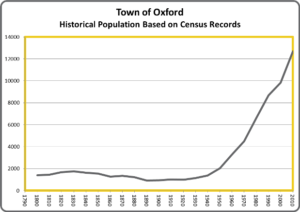
Over Time: Oxford’s Historical Population
Census data, from colonial times on up to the present, is a key resource for those who study the ways in which communities change with the passage of time.
Read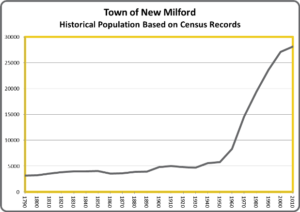
Over Time: New Milford’s Historical Population
Census data, from colonial times on up to the present, is a key resource for those who study the ways in which communities change with the passage of time.
Read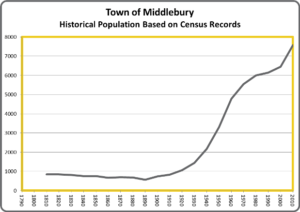
Over Time: Middlebury’s Historical Population
Census data, from colonial times on up to the present, is a key resource for those who study the ways in which communities change with the passage of time.
Read
Over Time: Glastonbury’s Historical Population
Census data, from colonial times on up to the present, is a key resource for those who study the ways in which communities change with the passage of time.
Read
Over Time: Middlefield’s Historical Population
Census data, from colonial times on up to the present, is a key resource for those who study the ways in which communities change with the passage of time.
Read
Over Time: Portland’s Historical Population
Census data, from colonial times on up to the present, is a key resource for those who study the ways in which communities change with the passage of time.
Read
Over Time: Simsbury’s Historical Population
Census data, from colonial times on up to the present, is a key resource for those who study the ways in which communities change with the passage of time.
Read
Over Time: Bethlehem’s Historical Population
Census data, from colonial times on up to the present, is a key resource for those who study the ways in which communities change with the passage of time.
Read
Over Time: Manchester’s Historical Population
Census data, from colonial times on up to the present, is a key resource for those who study the ways in which communities change with the passage of time.
Read
Over Time: Canaan’s Historical Population
Census data, from colonial times on up to the present, is a key resource for those who study the ways in which communities change with the passage of time.
Read
Over Time: Wethersfield’s Historical Population
Census data, from colonial times on up to the present, is a key resource for those who study the ways in which communities change with the passage of time.
Read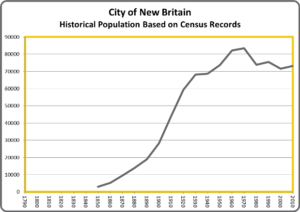
Over Time: New Britain’s Historical Population
Census data, from colonial times on up to the present, is a key resource for those who study the ways in which communities change with the passage of time.
Read
Over Time: Southbury’s Historical Population
Census data, from colonial times on up to the present, is a key resource for those who study the ways in which communities change with the passage of time.
Read
Over Time: Morris’ Historical Population
Census data, from colonial times on up to the present, is a key resource for those who study the ways in which communities change with the passage of time.
Read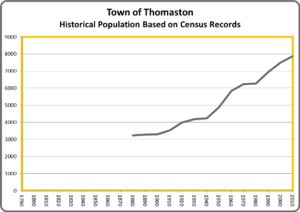
Over Time: Thomaston’s Historical Population
Census data, from colonial times on up to the present, is a key resource for those who study the ways in which communities change with the passage of time.
Read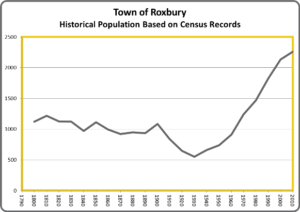
Over Time: Roxbury’s Historical Population
Census data, from colonial times on up to the present, is a key resource for those who study the ways in which communities change with the passage of time.
Read
Over Time: Bridgewater’s Historical Population
Census data, from colonial times on up to the present, is a key resource for those who study the ways in which communities change with the passage of time.
Read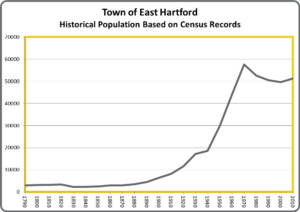
Over Time: East Hartford’s Historical Population
Census data, from colonial times on up to the present, is a key resource for those who study the ways in which communities change with the passage of time.
Read
Over Time: Canton’s Historical Population
Census data, from colonial times on up to the present, is a key resource for those who study the ways in which communities change with the passage of time.
Read
Over Time: Enfield’s Historical Population
Census data, from colonial times on up to the present, is a key resource for those who study the ways in which communities change with the passage of time.
Read
Over Time: Cornwall’s Historical Population
Census data, from colonial times on up to the present, is a key resource for those who study the ways in which communities change with the passage of time.
Read
Over Time: Bloomfield’s Historical Population
Census data, from colonial times on up to the present, is a key resource for those who study the ways in which communities change with the passage of time.
Read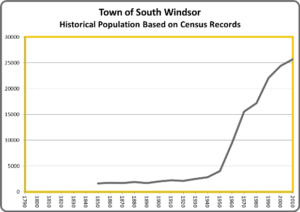
Over Time: South Windsor’s Historical Population
Census data, from colonial times on up to the present, is a key resource for those who study the ways in which communities change with the passage of time.
Read
Over Time: East Windsor’s Historical Population
Census data, from colonial times on up to the present, is a key resource for those who study the ways in which communities change with the passage of time.
Read
Over Time: North Canaan’s Historical Population
Census data, from colonial times on up to the present, is a key resource for those who study the ways in which communities change with the passage of time.
Read
Over Time: Newington’s Historical Population
Census data, from colonial times on up to the present, is a key resource for those who study the ways in which communities change with the passage of time.
Read
Over Time: Goshen’s Historical Population
Census data, from colonial times on up to the present, is a key resource for those who study the ways in which communities change with the passage of time.
Read
Over Time: East Hampton’s Historical Population
Census data, from colonial times on up to the present, is a key resource for those who study the ways in which communities change with the passage of time.
Read
Over Time: Warren’s Historical Population
Census data, from colonial times on up to the present, is a key resource for those who study the ways in which communities change with the passage of time.
Read
Over Time: Kent’s Historical Population
Census data, from colonial times on up to the present, is a key resource for those who study the ways in which communities change with the passage of time.
Read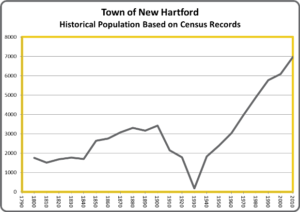
Over Time: New Hartford’s Historical Population
Census data, from colonial times on up to the present, is a key resource for those who study the ways in which communities change with the passage of time.
Read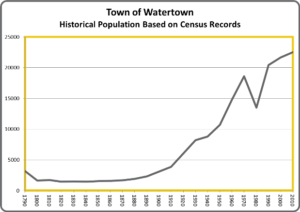
Over Time: Watertown’s Historical Population
Census data, from colonial times on up to the present, is a key resource for those who study the ways in which communities change with the passage of time.
Read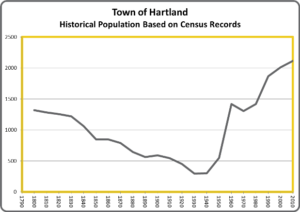
Over Time: Hartland’s Historical Population
Census data, from colonial times on up to the present, is a key resource for those who study the ways in which communities change with the passage of time.
Read
Over Time: Rocky Hill’s Historical Population
Census data, from colonial times on up to the present, is a key resource for those who study the ways in which communities change with the passage of time.
Read
Over Time: Southington’s Historical Population
Census data, from colonial times on up to the present, is a key resource for those who study the ways in which communities change with the passage of time.
Read
Over Time: Berlin’s Historical Population
Census data, from colonial times on up to the present, is a key resource for those who study the ways in which communities change with the passage of time.
Read
Over Time: Winchester’s Historical Population
Census data, from colonial times on up to the present, is a key resource for those who study the ways in which communities change with the passage of time.
Read
Over Time: Norfolk’s Historical Population
Census data, from colonial times on up to the present, is a key resource for those who study the ways in which communities change with the passage of time.
Read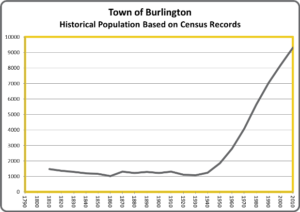
Over Time: Burlington’s Historical Population
Census data, from colonial times on up to the present, is a key resource for those who study the ways in which communities change with the passage of time.
Read
Over Time: Litchfield’s Historical Population
Census data, from colonial times on up to the present, is a key resource for those who study the ways in which communities change with the passage of time.
Read
Over Time: Salisbury’s Historical Population
Census data, from colonial times on up to the present, is a key resource for those who study the ways in which communities change with the passage of time.
Read
Over Time: Colebrook’s Historical Population
Census data, from colonial times on up to the present, is a key resource for those who study the ways in which communities change with the passage of time.
Read
Over Time: Hartford’s Historical Population
Census data, from colonial times on up to the present, is a key resource for those who study the ways in which communities change with the passage of time.
Read
Over Time: Meriden’s Historical Population
Census data, from colonial times on up to the present, is a key resource for those who study the ways in which communities change with the passage of time.
Read
Over Time: Granby’s Historical Population
Census data, from colonial times on up to the present, is a key resource for those who study the ways in which communities change with the passage of time.
Read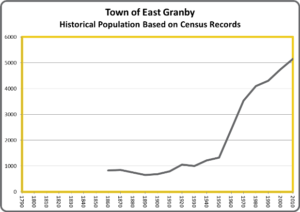
Over Time: East Granby’s Historical Population
Census data, from colonial times on up to the present, is a key resource for those who study the ways in which communities change with the passage of time.
Read
Over Time: Farmington’s Historical Population
Census data, from colonial times on up to the present, is a key resource for those who study the ways in which communities change with the passage of time.
Read
Over Time: Windsor’s Historical Population
Census data, from colonial times on up to the present, is a key resource for those who study the ways in which communities change with the passage of time.
Read
Over Time: Suffield’s Historical Population
Census data, from colonial times on up to the present, is a key resource for those who study the ways in which communities change with the passage of time.
Read
Over Time: Plainville’s Historical Population
Census data, from colonial times on up to the present, is a key resource for those who study the ways in which communities change with the passage of time.
Read
Over Time: Middletown’s Historical Population
Census data, from colonial times on up to the present, is a key resource for those who study the ways in which communities change with the passage of time.
Read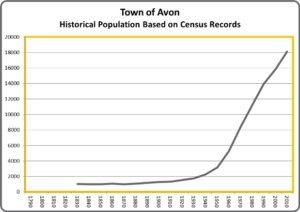
Over Time: Avon’s Historical Population
Census data, from colonial times on up to the present, is a key resource for those who study the ways in which communities change with the passage of time.
Read
Over Time: Cromwell’s Historical Population
Census data, from colonial times on up to the present, is a key resource for those who study the ways in which communities change with the passage of time.
Read
Over Time: Ashford’s Historical Population
Census data, from colonial times on up to the present, is a key resource for those who study the ways in which communities change with the passage of time.
Read
Over Time: Andover’s Historical Population
Census data, from colonial times on up to the present, is a key resource for those who study the ways in which communities change with the passage of time.
Read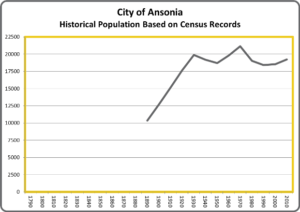
Over Time: Ansonia’s Historical Population
Census data, from colonial times on up to the present, is a key resource for those who study the ways in which communities change with the passage of time.
Read
Over Time: Sharon’s Historical Population
Census data, from colonial times on up to the present, is a key resource for those who study the ways in which communities change with the passage of time.
Read
Over Time: Windsor Locks’ Historical Population
Census data, from colonial times on up to the present, is a key resource for those who study the ways in which communities change with the passage of time.
Read
Video – When Disaster Struck: The 1938 Hurricane, Part 3
The CPTV Original, When Disaster Struck Connecticut, provides an in-depth look at the four major natural disasters that befell Connecticut between 1888 and 1955.
Read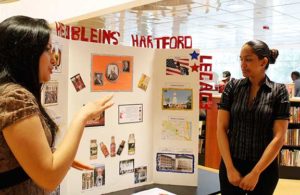
Capital Community College Students Explore Hartford’s Immigrant History…In Their Own Words
Capital Community College students explored important figures from Hartford’s history and their immigrant, migrant, or ethnic communities that culminated in semester-long research projects.
Read
Video – Connecticut’s Cultural Treasures: Litchfield Historical Society
Connecticut’s Cultural Treasures is a series of 50 five-minute film vignettes that profiles a variety of the state’s most notable cultural resources.
Read
Video – When Disaster Struck Connecticut: The Flood of 1955
The CPTV Original, When Disaster Struck Connecticut, provides an in-depth look at the four major natural disasters that befell Connecticut between 1888 and 1955.
Read
Video – Connecticut’s Cultural Treasures: Wadsworth Atheneum Museum of Art
Connecticut’s Cultural Treasures is a series of 50 five-minute film vignettes that profiles a variety of the state’s most notable cultural resources.
Read
Video – Connecticut’s Cultural Treasures: Phelps-Hatheway House and Garden
Connecticut’s Cultural Treasures is a series of 50 five-minute film vignettes that profiles a variety of the state’s most notable cultural resources.
Read
Video – Connecticut’s Cultural Treasures: Bush-Holley House
Connecticut’s Cultural Treasures is a series of 50 five-minute film vignettes that profiles a variety of the state’s most notable cultural resources.
Read
Trinity College Students Call Attention to Histories of Inequality
Trinity College students in Professor Jack Dougherty’s “Cities, Suburbs & Schools” seminar collaborated with the ConnecticutHistory.org team during the 2012-13 and 2013-14 school years.
Read
Video – Connecticut’s Cultural Treasures: Samuel Huntington
Connecticut’s Cultural Treasures is a series of 50 five-minute film vignettes that profiles a variety of the state’s most notable cultural resources.
Read
Video – Home Front: Connecticut During World War II – Civil Defense
This excerpt from the Connecticut Experience series provides a glimpse into the people, places, and events that have shaped our state’s history.
Read
Video – Home Front: A State Divided as War Looms in Europe
This excerpt from the Connecticut Experience series provides a glimpse into the people, places, and events that have shaped our state’s history.
Read
Video – Connecticut’s Cultural Treasures: Florence Griswold Museum
Connecticut’s Cultural Treasures is a series of 50 five-minute film vignettes that profiles a variety of the state’s most notable cultural resources
Read
Video – Connecticut’s Cultural Treasures: Mashantucket Pequot Museum and Research Center
Connecticut’s Cultural Treasures is a series of 50 five-minute film vignettes that profiles a variety of the state’s most notable cultural resources
Read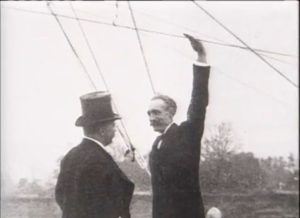
Video – Gifford Pinchot: America’s First Forester
A public television adaptation of Gary Hines’ one-man play about the first Chief of the Forest Service, Gifford Pinchot.
Read
Video – Connecticut’s Cultural Treasures: Old State House
Connecticut’s Cultural Treasures is a series of 50 five-minute film vignettes that profiles a variety of the state’s most notable cultural resources.
Read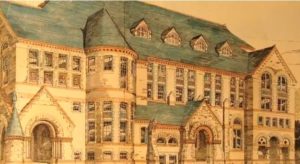
Video – Connecticut’s Cultural Treasures: Slater Memorial Museum
Connecticut’s Cultural Treasures is a series of 50 five-minute film vignettes that profiles a variety of the state’s most notable cultural resources.
Read
Video – Connecticut’s Cultural Treasures: Mark Twain House
Connecticut’s Cultural Treasures is a series of 50 five-minute film vignettes that profiles a variety of the state’s most notable cultural resources.
Read
Video – Connecticut’s Cultural Treasures: Lebanon Green
Connecticut’s Cultural Treasures is a series of 50 five-minute film vignettes that profiles a variety of the state’s most notable cultural resources.
Read
Video – Hidden History: Old Hartford State House
Your Town’s History in Video: Old Hartford State House
Read
Video – Connecticut’s Cultural Treasures: New Britian Museum of American Art
Connecticut’s Cultural Treasures is a series of 50 five-minute film vignettes that profiles a variety of the state’s most notable cultural resources.
Read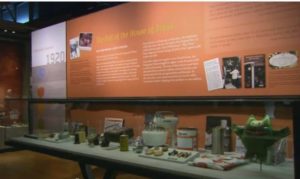
Video – Connecticut’s Cultural Treasures: Mattatuck Museum
Connecticut’s Cultural Treasures is a series of 50 five-minute film vignettes that profiles a variety of the state’s most notable cultural resources.
Read
Video – Hidden History: Soldiers and Sailors Memorial Arch
Your Town’s History in Video: Soldiers and Sailors Memorial Arch
Read
Video – When Disaster Struck: The 1938 Hurricane, Part 2
The CPTV Original, When Disaster Struck Connecticut, provides an in-depth look at the four major natural disasters that befell Connecticut between 1888 and 1955.
Read
Video – Hidden History: Hartford’s Ancient Burial Ground
Your Town’s History in Video: Hartford’s Ancient Burial Ground
Read
Video – Hidden History: Connecticut Historical Society
Your Town’s History in Video: Connecticut Historical Society
ReadMore Articles



